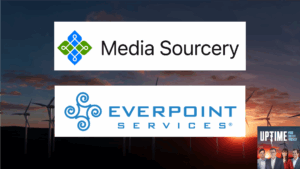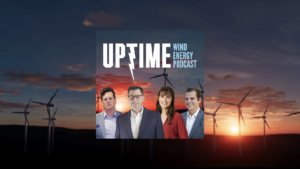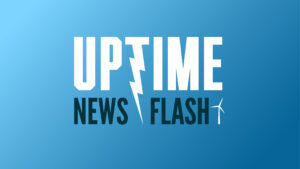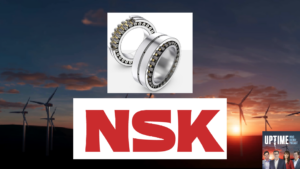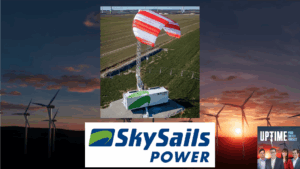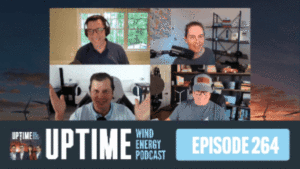What kind of technology is behind the new GE Cypress 6MW wind turbine? How will Orsted’s new onshore partnership with Siemens Gamesa pan out? Allen and Dan also discuss the potential of 3D printing for blade prototypes and new technologies, as the ORE Catapult invests in the technology. And, does ocean acidity cause more lightning strikes?
Learn more about Weather Guard Lightning Tech’s StrikeTape Wind Turbine LPS retrofit. Follow the show on YouTube, Twitter, Linkedin and visit Weather Guard on the web. Have a question we can answer on the show? Email us!
Podcast: Play in new window | Download
Transcript: EP40 – The New GE Cypress 6MW Wind Turbine; Orsted Partners with SGRE on Onshore, 3D Printed Blade Prototypes
This episode is brought to you by weather guard, lightening tech at weather guard, we make wind turbine lightning protection easy. If you’re a wind farm operator, stop settling for damaged turbine blades and constant downtime. Get your uptime back with our strike table lightening protection system.
Learn more in today’s show notes or visit weather guard, wind.com/strike tape
and blew it. And this is the uptime podcast where we talk about wind energy engineering, lightening protection, and ways to keep your wind turbines running.
all right. Welcome back to the uptime podcast. This is episode 40 and on today’s episode, we’re going to talk about a recent, uh, article in wind systems mag that featured weather guard, lightening tech. So cool, little quick hit there. Some news on the Nobles to wind farm. Uh, Siemens Gamesa now partnering with Orstad on their first onshore project, which is, uh, really commercially interesting.
Um, some. Interesting topics out of Australia. One of their coal plants, um, has been essentially written down as worthless. So we’ll talk about the tax implications and just the story in general, which seems a little bit strange. Um, and then in the last, in our new segment, we’ll talk about ocean acidity and does this actually.
Um, purport to increase lightening strikes on water in our tech segment, where it’s all about the GE Cypress, their new C uh, six megawatt wind turbine. And then lastly, catapult, uh, the, or either doing some additive, they’re adding an additive sell potentially exploring new 3d printing technologies for wind turbine blades in the future and other aspects of technology.
So, Alan, let’s start with Noble’s too. They’ve had some issues with, uh, lightening. It seems they have, they have some brand new Vestas turbines and the site just got turned on a couple of days ago, from what we can tell it’s up in Minnesota. And they’ve had seven blades already damaged by lightning. Six of them are going to be removed and re repaired slash replace.
Uh, it sounds like one’s going to be trying to repair in situ on the turbine is what it sounds like. So that the site has barely even started and they have six blades that are getting essentially replaced for some lightening protection issue. And the press release is funny because it does say that Festus knows they have a, the B one 36 blades, as it’s described, have a known lightening issue once which.
What we reported earlier a couple of months ago on the, wasn’t it Dan? $175 million right down from Vestas for lightening issues. Yeah. So it must be all tied together is, but we haven’t heard exactly what the lightening issue is. Besides her seeing lightening damage. Have you seen anywhere where it’s discussing what the engineering issue.
Is no, they’re keeping it pretty close to the, to the, to the Vestas thing. Uh, and yeah, I I’ve we’ve you and I both scoured the web and haven’t really found much on it. So it seems like it’s a. Trying to keep it proprietary, I suppose. It’s but all the, the operators must know at this point, uh, or at least you think that Vestas would have reached out to the effected operators to tell them to keep an eye on this situation, because you just don’t want a blade breaking off and hitting the ground.
If you can avoid it just too much risks to employees. But I think it is interesting that it is so quiet in the press about what the, what the issue is. There’s just no, Curiosity about what actually is causing this, which is, I think it’s unusual because in most of these type of situations, we would know something about what the engineering issue is, but it’s tightly held.
Yeah, for sure. Well, and that brings up, um, your feature article and wind systems magazine. So you had a company profile Q and a. Um, tell us a little bit about what you shared. And it’s interesting because whether our lighting tech is unique in the wind industry, like there’s not really other companies that are focused on an outside solution from a blade manufacturer to repairing these lightening issues, right?
Because once the blade is in service, there’s really not a lot you can do to the blade to improve its lightning protection. So our, our product, which is, uh, technically. Define as a segment of lightning, diverter is something that could be added onto the exterior blade, near the receptors, and greatly increases the lightening attachments to the receptors and away from the structure.
So it’s, it’s a relatively simple upgrade to most wind turbines. Uh, and you’re right. There’s not a lot of other things you can do to a turbine right now on lightning protection side, besides. Start cutting into the structure and doing major overhauls to the, to the ballet, which involves then of course, taking the blade off the turbine and having a crane and having people on site and all, all the expenses that are tied up in that were our solution.
Involves, uh, standard technicians working on ropes, uh, adding it, uh, adding our product to the, to the receptor areas of the blades with no structural implications to the blade itself. So, you know, it’s just a cleaner solution for most blades that are out there today. Well, and a quote from you from the article is that protecting the blade typically only requires a couple of feet of strike tape, which is your lightning diverter strip.
And, uh, I mean, that should come as like a breath of fresh air for companies that. Like, yeah, we are having a lot of lighting issues like, Hmm. Maybe we should just give this a try if it’s just a quick, you know, send someone up there, put on some, a poxy and apply a couple of feet of it, right? Yeah. It doesn’t take a lot of strike tape to greatly improve the blade lightening protection.
As we talk to the operators and managers at different wind sites across the world, they’re, they’re kind of shocked how inexpensive it is to, to do this. And it, it usually doesn’t take a great deal of energy or time to, to install it. And if you have technicians that are scheduled to be up already, then putting in improving your lightning protection system is really, really easy and inexpensive.
So it really makes a lot of sense to, to. Make that improvement when you can. Right. And right now we’re into December and is getting their Christmas and new year. A lot of, uh, winter run managers are scheduling for the springtime and that’s what we’re involved in right now. It’s a lot of scheduling for the springtime.
As soon as the snow melts and making get back onto the site, they wouldn’t going to start making the repairs that happened late in the season this year, and then making the upgrades for a variety of reasons. If it’s for techs, generators, or. Diction structural problems are having. And on top of that, they want to increase the resiliency of the lightening protection system.
So our strike date product is really fits in nicely to what the, uh, operators and managers are scheduling into the spring. Yeah. So definitely jump over to wind systems, mag.com and we’ll put the link in the show notes below, so you can check out the article on weather guard, lightening tech. Uh, so moving on.
Or stead and Siemens Gamesa are partnering for an onshore project for the first time. So the haystack 298 megawatt, uh, wind project in Nebraska is going to feature 51, Siemens Gamesa, 5.0 dash one 45, wind turbines. Again, the lovely names. Um, we’ll talk about GE with their Cyprus turbines later. Um, But they hope to come online.
Uh, it’s supposed to come online in the end of what socio fourth quarter of 2021. Maybe that’s a, I mean, that seems really ambitious, but that’d be cool if they get this up and running by next year. So why is this significant? I mean, obviously horse stead and Siemens companies have worked on off shore quite a bit together, but do you feel like this is going to be another longterm?
Is this the first of many. On short projects for them. I think onshore for them is going to happen more and more as they realize there’s opportunities to do it. And, uh, it’s took to put a wind turbine site in Nebraska is relatively simple because there’s not a lot of obstacles in your way. You’re not putting on a top of mountain tops.
You’re not. You’re not, you know, it’s easy, easy in, easy out. Uh, you have plenty of available people to work on these things. So, uh, the, the wind turbine sites up in sort of North Eastern, Nebraska, closer to the South Dakota border, which is mainly farm country. And if you can find opportunities like this, which are relatively simple, To get in and get out and start producing energy and, and getting your return on your investment.
You’re definitely going to do it. Or state obviously has been mostly involved on offshore with Siemens COMESA, COMESA COMESA itself has built, uh, numerous and Siemens too has built numerous onshore turbans for forever. So now it’s just another opportunity to sort of grow together. Not, I know they’re trying to build that relationship and it makes sense from an doorstep.
Point of view. It makes sense to have that long-term relationship with a company that you’ve worked with and trust and, and can get projects done. Because the most important thing about all of this is that the project gets done on time and you’re not overspending to get it in place. Right. So consistency of the project costs and the timeline is really important to the bottom line of the project.
Yeah. And then, so tying into that, it’s interesting. It says it’ll power up to 85,000 homes, which is just an insane amount of mental homes. That’s, it’s really interesting what, uh, obviously wind power can do. And so there’s a story out of Australia where the blue waters, coal fired energy plant is now being written off by their Japanese owners as worthless on the books.
So obviously this has tax applications and all that. This isn’t necessarily saying that they’re shutting down the plant. Right. But this is saying. Uh, they’re, they’re not super excited about their prospects of getting their money back in the future, but what, what jumps out at you this article? And is this going to be a trend going forward?
I mean, our coal plants essentially going to be obsolete. Well, I don’t know if they’re going to be obsolete, but there’s, it’s going to be harder and harder to operate them without having, uh, restrictions, severe restrictions placed upon them. Obviously there are different versions of coal fired plants, right?
So in the United States, there was a big effort to clean up the emissions from the coal fire plants. And some of them have shut down the United States. Uh, there really hasn’t been a new coal fire plant built in United States in a couple of years. So it’s just going to get harder and harder, harder to do.
I think, uh, it does when you get into these large financial transactions and we’re talking about a billion plus dollars here, when you start talking about financing a billion plus dollars, there’s a lot of implications into that of, uh, who’s holding a note, how much interest they want you to pay on the loan?
When do they want it paid by? Uh, can you afford to make the payments? How. If you think about it in a large corporation like that, essentially what they do is they make every single project that’s owned separate company. So if one of them goes down, they can just segregate it from the other companies that may be making money and sort of write it off or bankrupt that part of the company.
So that’s when the negotiations started by who’s paying, what is it going to bankruptcy court? That’s sounds like where they’re headed right now. So there’s the say that they’re gonna shut down the plant, I think is. That was a lot of variables that go into how you finance and what value you place on a particular asset for any company, not just a coal fire plant.
So it’s going to be, uh, interesting to watch and hopefully the, the media reports actually what’s going on because the conjecture is, well, there’s so much solar in Australia. They don’t need coal fire plants. I don’t think that’s true because at nighttime, what are you going to do? Right? But if there is a need for some continual power source, During the cloudy days and, and at nighttime, uh, to keep the lights on in Australia.
So they need some other, uh, power source. Coal has been an easy one for them, but, um, you know, as the energy fluctuates and all that kind of all the variables that applied there, it’s putting stress on the financing of Colfax plants. For sure. Yeah. So last story here in our new section. Ocean acidification may be increasing the intensity of lightning over the oceans.
Alan, I’m just gonna let you run with us. So this is a research study out of, uh, nature.com published this article, and it’s got a lot of references, um, very academic paper, but you’ve got some issues with the summary and conclusions. I, I believe well, if you read through the article or a paper, you get. To the actual testing or the simulation that they create.
And this is based on some tests and they did with a high voltage power supply, two electrodes and some water it’s essentially yet. But the, the test was run such that if you think about in very simplistic terms here, you got an electrode, one centimeter above some water and in the water, three centimeters deep is an another electrode.
And then they’re changing the alkalinity of the water as a, as they run these little experiments to see how the flashover happens between the electrode, above the water and electricity and the water itself. That’s generically what’s happening there. And then, but the, and so the re recorded data, all that all that’s fine.
All the recorded data there, whatever. When the extrapolation happens between this little laboratory experiment and I’m a little. Laboratory experiment that they’re moving RX four centimeters, which is a little under two inches. Uh, and you’re trying to extrapolate that to world lightning strikes and lightning and to any lightning strike, which the lightning channel is moving a mile or two before it hits the ground.
There is there’s really no correlation between them. It’s all conjecture, because if you think about, uh, the S acidity the most, let’s just describe it a little different terms. Lightning strikes all over the world and there’s all kinds of soil. Forget about the ocean for a minute. There’s all kinds of soil, Rocky, uh, mountains to very, uh, black, nutritious dirt all over the place.
The ground doesn’t really change the ground resistance or the ground composition on the ground. Alkalinity acidity, whatever does it change whether lightening happens there or not because lightning mostly starts in the cloud and starts traveling towards the earth and it doesn’t really care where it goes.
It’s already started. The cloud started the process. The ground is just the recipient of it. Same thing for the ocean. It’s just going to be the recipient lightening. So like, so making an argument that global and what they’re trying to make as this argument, that the, um, The assists, the oceans would become more acidic, acidic over time because of CO2 in the air and CO2 in the oceans.
It’s going more acidic. Therefore it’s going to change the nature of lightning strikes. That’s a huge stretch. Now, the problem I have with, I don’t have a problem with the experimental set that they document all that’s fine, where I have trouble is when they try to extrapolate to the, to the global lightning.
World. How accurate is that? And quite honestly, when you make those kinds of statements in the show up in nature.com, you better be able to back that up and you should be held somewhat responsible for writing that article. Because if it turns out that’s not the case, then. Why was it written in the first place you’re making a huge leap.
And I know what happens is that there’s that incentive to do that because it gets you in nature. What it does. If you could say global warming, it’s going to be catastrophic to the world. That’s going to get you in nature. If you’re seeing, um, some global change is going to make it better for life, it’s probably not going to be in nature, honestly.
Right. Uh, it’s sort of the dog bites, a man man bites, dog scenario, right. And the man bites dog is going to be in the paper. So. I think there’s gotta be consequences here. Not consequences in the sense of, you know, there should be some financial, this, these authors should be sued if it doesn’t work out.
But I do think we know you got to follow their work and see if, if their trend of work is actually producing. Reliable results or is it not? And if it doesn’t, then we need to discount that. So you’re taking a risk as a scientist to put this out there and to make these kinds of claims versus just saying, Hey, we did some experiments on the alkalinity of water or the acidity of water, and it’s changing the way electrical sparks happen.
Fine. So I’m just troubled by this. And I see it a lot more recently, uh, on the sort of the global claims of lightning lightning is going to increase because of global warming. Lightning is going to decrease. Lightning is going to cause more fires. Lightning is not going to cause more fires. You can get both sides of it and it gets back to trusting quote-unquote experts.
Right? You have to have some sense of, uh, skepticism and any of this. When it makes global predictions, just, you just have to
right. So in our tech segment today, we’re going to start with the new GE Cyprus. They have a six megawatt, uh, on shore wind turbines, their biggest of their Cypress family. And one of the really interesting, and that’s what I want your take on Allen. Well, the interesting aspects of this is, uh, the blades are two pieces.
So we talked about this a little bit in the past. It’s hard to find a lot of information on the exact, you know, technical specifications and how these are fit together. Right. Um, you know, article from composite world. Shows, uh, interesting drawing of a Siemens Gamesa, two piece blade. So that’s helpful. And probably just, they’re probably similar, right?
I’m sure that designs aren’t incredibly awkward. The general principles are probably the same, but you know, before we get into some of the power production specs, how do you feel about the two piece blade design? And are we going on the assumption that GE has done a lot of testing and, um, I mean, that seems to be the assumption, right?
That they’re like, Hey, this is good to go. Or is it still like. Yeah. To be seen if these blades are still intact five, 10 years from now. Yeah. Uh, when they, the, the issue is not so much that it’s a two-piece blade, it’s a two-piece blade with carbon fiber. And from the lightening standpoint, you’ve basically broken the electrical path between the tip.
And the root of the blade was some sort of structural joint, which has also now an electrical joint. So if you take a lightning strike to the tip, it’s going to travel down some way. Some part of it’s going to be in the carbon fiber. It’s hard to avoid that. It’s going to cross through that joint. Even some part of the lightning is going to go through that joint.
I don’t know how you would avoid that and then rushed down to the hub. So the question is structurally, can it handle it more than likely they have to G you would have to have done. Hours and hours, hours of one, uh, simulations, and then actual structural testing to verify this, the joint of that blade does make sure that it’s going to basically fatigue, test it, to make sure it’s going to last a 20 year life span in which they’re saying it will.
The second part though, is sort of the randomness of lightening and how lightning is going to affect those blades. As we have just seen with Festus on their one 36, uh, blades, they thought they had a blade that was fine. And then they put out in service and then it doesn’t work. And so there was some variability enlightening, which is not necessarily getting incorporated into the basic blade design.
And when you add the variable of carbon fiber to it, it gets even more complex than just basic fiberglass blades. So. You hope that they’ve thought through this enough and are monitoring it enough. Y’all part of my, when I started reading about sort of the, the segment of blades are two PS blades. My thought was first, you need to instrument it to monitor that joint.
You need to make sure that if I’m sure it’s some sort of bolted joint, do you need to make sure that the bolts are doing what they said they’re going to be doing that nothing is coming loose at the loads in that joint are as predicted in your computer models. You should be doing that. So as soon as you start to instrument, uh, those blades, which hopefully they’re doing, you’re putting wires and electrical pathways up into that joint also, which can get affected by lightening.
So it’s a very, very, very complicated problem that they’re gonna have. We’re gonna have to just continue to monitor as time goes forward. The reason for the two piece blades obviously is to sort of the transportation manufacturing costs, manufacturing costs are going up because you’re gonna create this really.
Intricate splice joint of some sort. So the manufacturing costs are going to go up, but, uh, the intent is so that you can, you’re having easier access or smaller split blade sections to transport, to maybe more remote areas, which also makes sense. Right? So they’re planning a trade off between the cost of the manufacturing effort versus the cost of the transportation effort.
And somewhere there’s a happy medium, but Dan, you know, I, it just, all these, uh, since we, since the winter ministry, hasn’t. It doesn’t seem to have a great handle on lightning protection right now. It just, it’s just a note of caution. I K we just got to keep an eye on it. Yeah. And it seems like, like you said, that’s the variable, they can as much control for like, obviously with construction techniques, all these new skyscrapers and buildings.
I mean, they’re all designing these solutions and these joints and, you know, they go up on these buildings and they expect they expect them to work and they do right. So. I guess you would assume that the same thing would be true with, you know, like this joint on these blades and all the engineering and manufacturing, but like you said, those are other variables that they’re not, they’re not really, they can’t really test shooting lightening through the joint over and over and over.
Right. So that seems like a, something that they’re not gonna know until it’s out in the field. Very hard to predict. And based upon where the first installations, where you may have a very. False positive in a sense that you just don’t take a lot of lightning strikes at versus if you put them on the West coast of Japan or places in Italy or on Korean Coratia or locations, which have really high intensity lightening, you may get a totally different answer from them as places.
So, uh, even some of the first installation may not tell you a lot. Long-term yeah. Well, and, and this one’s a. It’s an enormous turbine, right? It’s a hundred, they have two versions, 112 or 167 meter hub height, which is just gigantic 164 meter rotor diameter. So it’s going to be imposing driving up and seeing those in, in Nebraska.
And that’s so big. It’s like, I don’t, this is not a technical, that’s just, that’s so big. These things are huge. Especially in that grief in Nebraska and places or Kansas or Oklahoma places where, or Iowa places where it’s normally flat, you don’t have anything relative to put it up against. It’s gets a little hard to tell how close you are to some of these wind turbines, because there’s no reference point anywhere.
There’s nothing around it. Besides corn and cows and farm land. So it’s, they, there they are enormous, enormous structures. Yeah. And I’d be curious what the noise profile is like and just all those other things. So I’m sure there. Like you said they just keep getting more and more complicated. That’s why you don’t see the 12 megawatt ones on onshore, because they’re just so besides Travis transportation and logistics and all that stuff just gigantic.
So last thing on the docket today. Um, some news out of the catapult facility in Scotland, and they were talking about doing, um, additive, they’re adding a cell of additive manufacturing. So, you know, the common term is 3d printing, right? So they just want to add this cell because they act as an accelerator.
And, um, they’re just trying to see how fast they can boost their offshore, renewable energy resources. So. Do you see 3d printing blades? This will be my first question to you about this. So they’re adding this, this cell to their accelerator, right. So they can do out of, um, in 3d printing. But do you see them actually being able to 3d print a blade or is this more just for prototypes and just being quicker to market with.
Testing things out well, conceptually you’d want to be able to 3d print blades wherever the turbans are going to be located. And that would be the ultimate goal is that you don’t have to transport the blades anywhere. You can actually make them on site. Uh, excuse me. So the, the only. Issue is transporting the raw material into the machinery on site.
Uh, so you can push out these blades, the 3d printed efforts that I have seen over the last year that have been more advanced, uh, you’re seeing 3d printed, uh, Products with mostly thermoplastics with fibers in them, carbon fiber fiberglass, mixed in with them that you can then, uh, lay into different forms.
It’s like a 3d printer kind of thing, but how effective that’s going to be on such large structures is yet to be determined. You think you’d see a lot more of it on, uh, on the aerospace side first because they have the cash to do it typically in the, in the, in the, in. Ability to invest in that longterm versus wind, which typically won’t do that.
But the Ori catapult is doing a lot of great things, quite honestly. So if you actually watch their website, LinkedIn page, you see all the, sort of the breakthrough things that they’re doing. And there’s really forcing the issue of here’s some technology areas we need to see improved. We’re going to put some funding behind it, and we’re going to create this a little bit of chaos, uh, too.
Look at different ideas, they’re always thorough. Some solutions let’s check them out. The 3d printed obviously is one of those solutions, which w you know, well, in the, in the top level of generic sense would be a great idea. If you could implement it. Obviously the problem is trying to implement something as complicated, technically complicated, and involves a lot of structural loads and those kinds of things.
So it’s not, um, It’s not a tomorrow project. Like we’re not going to see 3d printer blades in the next year, but five years down the road, possibly, but it’s going to take a lot of work to get there. Now, the different ways of, I mean, you’d know way more about the way they create carbon fiber and composite structures.
I mean, does it have to be, you know, layers of fabric and then the epoxy resins systems and all that, does it have to be sort of directionally like that? Because it seems like you lose some of that functionality when you’re doing 3d printing. Like you don’t right. Have the, you don’t have a length of a load sheet of carbon fiber, right?
Yeah, exactly. Right. So, uh, it’s think of it. A carbon fiber or fiberglass as being little bits of rope ropes are great intention, but they’re awful in compression. When you put coding on it, like an epoxy or some sort of thermoplastic, and you can also have some compression ability, but it doesn’t really like it.
So there’s a lot of things about it, but you’re right. When you have a chop fiber, uh, like on a boat, boats tend to be chopped fiberglass, epoxy sprayed on the, the, the, the load path. There’s really not a load path like that. Right. So on a blade. The low Plath is along the length of blade, obviously. Cause it’s the one surfaces intention when surfaces in compression most of the time.
So the complexities are much higher on something as complex as a winter and blade where you want to know. Where the fabric is going and how much fabric is going in that particular direction and what the, essentially the strength of that fabric is, this is why there’s this switch from fiberglass to carbon fiber slider, but it’s also stronger, uh, overall, so to speak.
So, yeah. Yeah. The, the 3d printed chop fiber things that I’ve seen the benefit of the chop fibers, it holds the plastic together better. It doesn’t, it’s not as brittle as some of the early 3d printed. Things are, but you’re right. You don’t have a consistent way to know how much load it can take and that’s going to be the trouble.
So would the application maybe be for like internal parts, like could print pieces of spar and just like other components maybe faster? I don’t think there’s going to be a, doing a spar, but uh, let me, uh, so like let’s, let’s look at the 3d, the two-piece blade that GE is talking about and Siemens Gamesa, we’re also doing somewhere in the middle of this.
Two piece blade. There there’s a joint. And in that joint, they’re going to have some sort of cover, well, you could 3d print the cover that fairing because there’s really no structural load there. It’s just a cover. So it’s something you could 3d print. Uh, and then there’s a lot of other uses for 3d printed products, aware just the complexities of making it, uh, machining apart are so expensive that it’s just easier just to print the thing.
Uh, but there are all kinds of applications for 3d printing in. Every aspect of life today, we haven’t just implemented it. We want to still expensive until we haven’t really figured out how to do it yet. So it’s a new technology and you always have to give new technology five to 10 years to kind of roll into fruition, sorta like the iPod.
It just takes a long time for people to realize they can put a thousand songs in their pocket. That ability was there five years prior, but no one had done it like Apple, same thing. He was happening, 3d printing. You’re seeing this sort of consolidation and, and, uh, All the engineers start to focus on a little bit more than they had five years ago and getting our students to email a lot more products in wind, in aerospace, in all aspects of life.
You’re gonna see a lot more 3d printed stuff coming out. All right. Well, we’re going to wrap up today’s episode of uptime. If you’re new to the show. Welcome. If you’re a regular here, thank you for your continued support. Please subscribe to the show and leave a review on iTunes, Spotify, or wherever you listen to podcasts.
Don’t forget to check out the weather guard, lightening tech YouTube channel for video episodes. Full interviews and short clips from each show for Alan and all of us at weather guard stay safe and we’ll see you next week.
is downtime causing you financial pain and putting a stop to your power production for months on end. It’s no secret lightning strike damage is a major cause of wind turbine downtime. This damage is preventable with our easy to install, strike tape lightning protection system for wind turbine blades are incredible engineering, build quality materials and ed sealants withstand up to five times more abuse in the toughest weather, enlightening conditions.
And we’ve got the research to prove it. If you’re tired of constant downtime, we can help reach out to us at weather guard, wind.com and schedule a free call. We’ll get your uptime back in no time.





